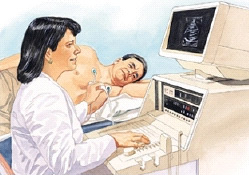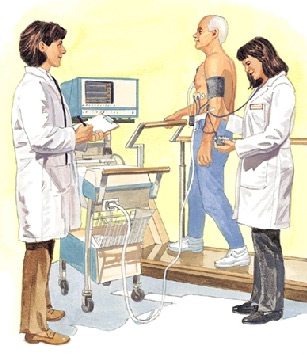Cardiac Imaging » Exercise Stress Echocardiogram
Stress echocardiography, or stress echo, is a test that records images of your heart before and after exercise. By comparing the images, your doctor can tell whether your heart is getting enough blood to meet its increased demand for oxygen.
Allow at least 1–2 hours from your arrival to the time you can leave.
Before Your Test
- Be sure to mention the medications you take and ask if it’s okay to take them before your test.
- Don’t eat, drink, smoke, or have any caffeine for 3 hours before test.
- Wear flat, comfortable walking shoes.
- Wear a shirt, blouse, or sweater that you can remove easily. You may be asked to remove your clothing from the waist up.

Images of your heart are recorded on videotape for your doctor to see later.
During Your Test
A transducer (a small device that produces sound waves) and gel are placed on your chest to record images on videotape of your heart at rest.
- Your blood pressure is also monitored, and electrodes are attached to your chest to record an electrocardiogram (EKG), a test that records the pattern of your heartbeat.
- Next, you’re asked to walk on a treadmill or pedal a stationary bicycle until your heart is beating rapidly. Note: If you are not able to exercise, you’ll be given a drug to get your heart working harder.
- Finally, a technician records a second set of video images of your heart immediately after you finish exercising.

You are asked to walk on a treadmill or pedal a stationary bicycle until your heart is beating rapidly.
After the Test
- You can resume your normal activity.
- Be sure to keep your follow-up appointment with your doctor to discuss test results.
During the test, be sure to tell the health care provider if you feel any chest, arm, or jaw discomfort, severe shortness of breath, fatigue, or dizziness.


